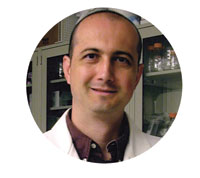Pitt Researchers Identify Protein That Is Key to Pulmonary Emphysema
 Ferruccio Galbiati
Ferruccio GalbiatiScientists at the University of Pittsburgh School of Medicine are blazing a trail down a molecular pathway that could lead to new treatments, and perhaps even prevention strategies, for the lung disease emphysema.
Their study indicates that blocking the activity of a structural protein called caveolin-1 stops free radical-induced aging and damage of fibroblasts, a kind of lung cell, in an animal model of emphysema.
Emphysema typically occurs after long periods of cigarette smoking. Toxins in the smoke destroy the walls of the alveoli, the tiny air-filled sacs in lung tissue where oxygen exchange happens, impairing lung function and ultimately leading to death owing to respiratory failure.
“It was thought that smoking-induced lung inflammation was the main reason for destruction of alveoli,” said senior investigator Ferruccio Galbiati, a professor of pharmacology and chemical biology in the School of Medicine. “Our findings indicate that the free radicals or oxidants produced by smoking accelerate the aging of lung fibroblasts, which may contribute to the pathogenesis of emphysema.”
Cells cannot replicate forever, he explained. After a certain number of divisions, the cycle stops because of a cellular aging process called senescence. Oxidative stress, meaning increased production of free radicals, can induce that process prematurely.
In Galbiati’s study, normal mice began to show signs of premature aging in lung fibroblasts after six weeks of exposure to cigarette smoke and developed pulmonary emphysema after six months. But premature senescence and emphysema induced by smoke exposure were significantly prevented in mice that lacked the gene to make caveolin-1.
“For our next step, we would like to identify drugs that can reduce the amount of caveolin-1 to see if they affect emphysema development,” Galbiati said. “That way, we might be able to slow down or perhaps prevent some of the lung damage that smoking causes.”
The research was supported by a grant from the National Institutes of Health. The study appeared in the Feb. 27, 2009, issue of the Journal of Biological Chemistry.
Other Stories From This Issue
On the Freedom Road

Follow a group of Pitt students on the Returning to the Roots of Civil Rights bus tour, a nine-day, 2,300-mile journey crisscrossing five states.
Day 1: The Awakening
Day 2: Deep Impressions
Day 3: Music, Montgomery, and More
Day 4: Looking Back, Looking Forward
Day 5: Learning to Remember
Day 6: The Mountaintop
Day 7: Slavery and Beyond
Day 8: Lessons to Bring Home
Day 9: Final Lessons

